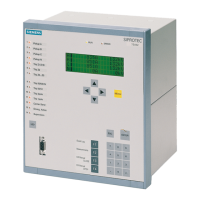2.15 Automatic Reclosure Function (optional)
289
7SD5 Manual
C53000-G1176-C169-1
pole tripping on the other hand are possible (for every reclose cycle). The protective
function that issues the trip command determines the type of trip: single-pole or three-
pole. Depending on the latter the dead time is selected.
In control mode PICKUP ...(With PICKUP...) different dead times can be set for
every reclosure cycle after single-phase
, two-phase and three-phase faults. Selection
of the dead time in this case depends on the type of fault determined by the initiating
protection function at the instant that the trip commands reset. This operating mode
allows the dead times to be dependent on the type of fault in the case of three-pole
reclose cycles.
Reclose Block Different conditions lead to blocking of the automatic reclosure. No reclosure is possi-
ble, for example, if it is blocked via a binary input. If the automatic reclosure has not
yet been started, it cannot be started at all. If a reclosure cycle is already in progress,
dynamic blocking takes place (see below).
Each individual cycle may also be blocked via binary input. In this case the cycle con-
cerned is declared as invalid and will be skipped in the sequence of permissible
cycles. If blocking takes place while the cycle concerned is already running, this leads
to aborting of the reclosure, i.e. no reclosure takes place even if other valid cycles
have been parameterized.
Internal blocking signals, with a limited duration, arise during the course of the reclose
cycles:
The reclaim time T-RECLAIM begins with every automatic reclosure command. If the
reclosure is successful, all the functions of the automatic reclosure return to the qui-
escent state at the end of the reclaim time; a fault after expiry of the reclaim time is
treated as a new fault in the network. Re-tripping by a protection function during the
reclaim time initiates the next reclose cycle in the case of multiple reclosure; if no
further reclosure is permitted, the last reclosure cycle is declared as unsuccessful if
re-tripping within the reclaim time takes place. The automatic reclosure is blocked dy-
namically.
The dynamic lock-out locks the reclosure for the duration of the dynamic lock-out time
(0.5 s). This occurs, for example, after a final
tripping or other events which block the
auto reclose function after it has been started. Restarting is locked out for this time.
When this time expires, the automatic reclosure function returns to its quiescent state
and is ready for a new fault in the power system.
If the circuit breaker is closed manually (by the control discrepancy switch connected
to a binary input, the local control functions or via one of the serial interfaces), the au-
tomatic reclosure is blocked for a manual-close-blocking time T-BLOCK MC. If a trip
command is issued during this time, it can be assumed that a metallic short-circuit is
the cause (e.g. closed earth switch). Every trip command within this time is therefore
a final trip. With the user definable logic functions (CFC) further control functions can
be processed in the same way as a manual–close command.
Interrogation of the
Circuit Breaker
Ready State
A precondition for automatic reclosure following clearance of a short-circuit is that the
circuit breaker is ready for at least one OPEN-CLOSE-OPEN-cycle when the automat-
ic reclosure circuit is started (i.e. at the time of the first trip command). The readiness
of the circuit breaker is signalled to the device through the binary input „>CB1
Ready“ (No. 371). If no such signal is available, the circuit breaker interrogation can
be suppressed (presetting) as automatic reclosure would otherwise not be possible at
all.
www . ElectricalPartManuals . com
